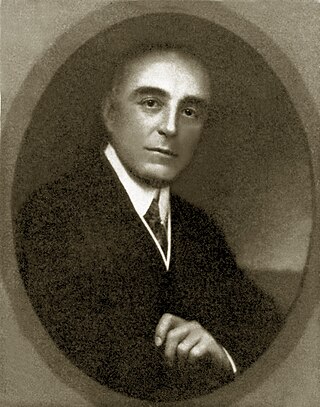
The Motion Picture Patents Company, founded in December 1908 and effectively terminated in 1915 after it lost a federal antitrust suit, was a trust of all the major US film companies and local foreign-branches, the leading film distributor and the biggest supplier of raw film stock, Eastman Kodak. The MPPC ended the domination of foreign films on US screens, standardized the manner in which films were distributed and exhibited within the US, and improved the quality of US motion pictures by internal competition. It also discouraged its members' entry into feature film production, and the use of outside financing, both to its members' eventual detriment.

Universal City Studios LLC, doing business as Universal Pictures is an American film production and distribution company, a division of Universal Studios, which is owned by NBCUniversal, a division of Comcast.

Florence Lawrence was a Canadian-American stage performer and film actress. She is often referred to as the "first movie star", and was long thought to be the first film actor to be named publicly until evidence published in 2019 indicated that the first named film star was French actor Max Linder. At the height of her fame in the 1910s, she was known as the "Biograph Girl" for work as one of the leading ladies in silent films from the Biograph Company. She appeared in almost 300 films for various motion picture companies throughout her career.

Carl Laemmle was a German-American film producer and the co-founder and, until 1934, owner of Universal Pictures. He produced or worked on over 400 films.

Universal City or Universal Studios Complex is an unincorporated area within the San Fernando Valley region of Los Angeles County, California, United States. Approximately 415 acres, within and immediately outside the area is the property of Universal Pictures, one of the five major film studios in the United States: about 70 percent of the studio's property is inside this unincorporated area, while the remaining 30 percent is within the Los Angeles city limits. Universal City is nearly surrounded by Los Angeles, with the area's northeastern corner touching the city of Burbank.

The Nestor Film Company, originally known as the Nestor Motion Picture Company, was an American motion picture production company. It was founded in 1909 as the West Coast production unit of the Centaur Film Company located in Bayonne, New Jersey. While not the first movie studio in Los Angeles, Nestor made great strides on October 27, 1911, by establishing the first permanent motion picture studio in Hollywood, California, and producing the first Hollywood films. The company later merged with its distributor, the Universal Film Manufacturing Company, on May 20, 1912. Nestor remained a recognizable brand name for Universal until at least the middle of 1917.

David Horsley was an English pioneer of the film industry. He founded the Centaur Film Company and its West Coast branch, the Nestor Film Company, which established the first film studio in Hollywood in 1911.
The Victor Film Company was a motion picture company formed in 1912 by movie star Florence Lawrence and her husband, Harry Solter. The company established Victor Studios in Fort Lee, New Jersey, when early film studios in America's first motion picture industry were based there at the beginning of the 20th century.

William Nicholas Selig was a vaudeville performer and pioneer of the American motion picture industry. His stage billing as Colonel Selig would be used for the rest of his career, even as he moved into film production.

The Selig Polyscope Company was an American motion picture company that was founded in 1896 by William Selig in Chicago, Illinois. The company produced hundreds of early, widely distributed commercial moving pictures, including the first films starring Tom Mix, Harold Lloyd, Colleen Moore, and Roscoe "Fatty" Arbuckle. Selig Polyscope also established Southern California's first permanent movie studio, in the historic Edendale district of Los Angeles.
The star system was the method of creating, promoting and exploiting stars in Hollywood films from the 1920s until the 1960s. Movie studios would select promising young actors and glamorise and create personas for them, often inventing new names and even new backgrounds. Examples of stars who went through the star system include Cary Grant, Joan Crawford, and Rock Hudson.

The Independent Moving Pictures Company (IMP) was a motion picture studio and production company founded in 1909 by Carl Laemmle. The company was based in New York City, with production facilities in Fort Lee, New Jersey. In 1912, IMP merged with several other production companies to form Universal Film Manufacturing Company, later renamed Universal Pictures Company with Laemmle as president.

Pierre Ernest Jules Brulatour was a pioneering executive figure in American silent cinema. Beginning as American distribution representative for Lumiere Brothers raw film stock in 1907, he joined producer Carl Laemmle in forming the Motion Picture Distributing and Sales Company in 1909, effectively weakening the stronghold of the Motion Picture Patents Company, headed by Thomas Edison, a large trust company that was then monopolizing the American film industry through contracts with hand-picked, established studios. By 1911 Brulatour was president of the Sales Company. He was a founder of the Universal Film Manufacturing Company, later known as Universal Pictures.

James Cruze was a silent film actor and film director.
Gaston Méliès was a French film director who worked primarily in the United States. He was the brother of the film director Georges Méliès.

James Young Deer, also known as J. Younger Johnson or Jim Young Deer, was actually born James Young Johnson in Washington, D.C. Although he was identified in the early Hollywood trade paper Moving Picture World as of the Winnebago Tribe of Nebraska, his ancestry is of the Nanticoke people of Delaware. He became an early film actor, director, writer, and producer. He is believed to be the first Native American filmmaker/producer in Hollywood. Together with his wife and partner Lillian St. Cyr, Winnebago, the couple were labeled an "influential force" in the production of one-reel Westerns during the first part of the silent film era. Their films, along with several others of the silent era, were notable for portraying Native Americans in a positive light.
The Centaur Film Company was an American motion picture production company founded in 1907 in Bayonne, New Jersey, by William and David Horsley. It was the first independent motion picture production company in the United States. In 1909 the company added a West Coast production unit, the Nestor Film Company, which established the first permanent film studio in Hollywood, California, in 1911. The company was absorbed by the Universal Film Manufacturing Company in 1912.

Providencia Ranch, part of Providencia Land and Water Development Company property named for the Rancho Providencia Mexican land grant, was a property in California, US. It was used as a filming location for the American Civil War battle scenes in The Birth of a Nation (1915) and other silent motion pictures. The valley was also the site for two Universal Studios west coast operations in 1914.

The American Film Manufacturing Company, also known as Flying “A” Studios, was an American motion picture production company. In 1915, the formal name was changed to the American Film Company.

United States v. Motion Picture Patents Co., 225 F. 800, was a civil antitrust prosecution overlapping to some extent with the issues in the decision in the Supreme Court's Motion Picture Patents case. After the trial court found that the defendants violated §§ 1 and 2 of the Sherman Act by establishing control over "trade in films, cameras, projecting machines, and other accessories of the motion picture business," by their patent licensing practices and other conduct, they appealed to the Supreme Court. After the Supreme Court's 1917 decision in Motion Picture Patents Co. v. Universal Film Manufacturing Co., however, the parties dismissed the appeal by stipulation in 1918 that the decision had made the defendants' appeal futile.






















